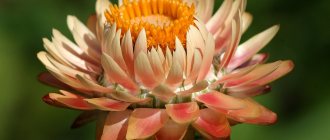Flower growers in many countries love to grow such a decorative flower as matthiola bicornuum. Planting and caring for it is incredibly simple, which allows you to not spend a lot of time and effort.
As night falls, mattiola begins to emit a delightful aroma that fills the entire garden.
At the moment, many different species are known, but the decorative properties of Matthiol bicornus are not too different. During the daytime, she hides the beautiful petals of her flowers.
Mattiola two-horned description and characteristics
Mattiola bicorna is planted annually, as it is ready to please for no more than a year. This flower is unusual and differs in many characteristics. Features include:
Mattiola has a straight or spreading stem, this fact depends on what variety it belongs to. A large number of shoots with thick fluff, like the foliage, are scattered throughout the flower;
If you properly care for the flower, it can reach 60 centimeters in height;
The bright green leaves are covered with large teeth;
Small and not too brightly colored flowers are collected in inflorescences whose shape resembles graceful brushes;
Flowers open after sunset and fill the entire garden with a pleasant aroma; with sunrise, the flowers close;
Matthiola blooms for a long time. It can last from the first days of summer and end only when frost comes;
The ripening of small seeds occurs in pods. Seeds can be stored for 3 years maintaining good germination.
Varieties
About 60 varieties of this plant grow in natural conditions. Mattiola also received such a name as “fragrant violet”. In garden plots you can only find matthiola two-horned and matthiola gray or levkoy, the second name. Thanks to the work of breeders, it was possible to develop a large number of different varieties of these species, whose aroma and color differ from each other.
Particularly popular among gardeners are the following varieties of matthiola bicorne:
- Evening aroma - a distinctive feature of this variety is considered to be straight shoots, which are especially branched. These bushes do not exceed half a meter in height. They have small lilac inflorescences emitting a bright, rich aroma;
- Starlight is an amazing flower from a varietal mixture. It opens with flowers of various colors and are located on straight stems whose height does not exceed 50 centimeters. Each of them has its own aroma, and together they create a fairy tale atmosphere in the garden. This variety is best suited for planting near the house;
- Mattiola pink - this flower can be an excellent decoration for the balcony. It does not exceed 30 centimeters in height. When opening, these pleasant lilac flowers, collected in a racemose inflorescence, emit a sweet scent.
- Lilac - this variety has good resistance to cold, but prefers to grow in sunny areas. Half a meter in height, this plant attracts everyone by emitting its soft and unique aroma.
- Summer Evening is a particularly favorite variety among gardeners. The height of this plant is half a meter, lilac flowers are collected in inflorescences-tassels and emit an unforgettable aroma, distinguished by its durability.
Cultivation
Mattiola is a herbaceous annual plant up to 50 cm high. Its leaves are small, jagged, and green. The fragrant flowers have a light purple hue. They open and smell fragrant in the evening, but by morning they close, their aroma dulls.
Mattiola blooms in the garden for 1 month. The seeds collected from it do not lose their viability for 3 years. The plant is cold-resistant, can withstand frosts down to -7°C. Mattiola will grow well in areas illuminated by direct sunlight, but will also tolerate partial shade. In too shaded places, the plant stems will stretch and the quality of the inflorescences will decrease.
Matthiola can grow on any soil, but on fertile soils with normal acidity, the development of bushes will be better and the aroma of flowers will be stronger. Watering should be moderate; in dry weather it increases significantly. The predecessors of matthiola should not be plants of the cruciferous family.
Important! It is recommended to plant matthiola in elevated areas, as it does not like excessive moisture.
Matthiola bicornuosa reproduction
The best way to plant matthiol is considered to be seed; seedlings are grown extremely rarely. The fact is that the root system of the flower is quite weak and may not survive replanting. However, enjoying all the beauty and aromas of these flowers at the very beginning of summer is only possible through seedlings.
First you need to prepare the container and fill it with a suitable mixture before sowing. The soil should be loose, nutritious, water- and breathable. Before planting, it is necessary to treat the container and soil with manganese.
Matthiola growing from seeds when to plant
For the older generation, our parents and grandparents, summer has its own unforgettable aroma - the smell of night violet. The flower resembles a sleeping beauty who, waking up in the evening, bewitches with her beauty. So it, inconspicuous during the day, enchants in the evening, intoxicating with its magical aroma. Now we will tell you about the flower - matthiola, growing from seeds, when to plant for seedlings, in open ground, we will reveal the nuances of care, we will talk about preventing possible diseases, how to get rid of pests.
Matthiola two-horned planting
- Sowing of seeds is carried out in early February. You can sow in March, but then the flowering time will be different.
- Sowing should be carried out on prepared soil with a distance of 4 centimeters from each other. The seeds do not need to be pressed into the soil; just sprinkle them lightly with soil. Next, you need to carefully pour water at room temperature and cover with film or glass.
- Containers with seeds should be placed in a well-lit place. You should not water until the first shoots appear.
In order for seedlings to grow well, certain conditions must be met. As soon as the first shoots appear, it is necessary to provide the plant with good lighting, and the air temperature should drop to +12 degrees, otherwise the seedlings will begin to stretch.
If seedlings are grown in seedling boxes, then planting should be done every 14 days. It is important to remember that matthiol has a very fragile root system, so the seedlings will die when transplanted, no matter how careful you are.
Well-moistened soil into which you plan to replant will help protect the roots from damage. You need to take out the plant one at a time, protecting its fragile roots. Before this, it is necessary to make planting holes in a new container into which the seedlings are transplanted. Next, they need to be covered with a layer of soil up to the leaves, carefully, using the pads of your fingers, compacted around each plant and watered well.
Gardeners with experience in growing matthiola do not pick seedlings. To grow without picking, you can use a box where eggs or chocolates were previously stored. These cells are filled with soil and 3 seeds are planted in each. When they all grow up, you can choose the strongest one and remove the rest.
Transplanting a flower to a place where the plant will grow permanently is carried out together with a lump of earth and with the onset of constantly warm weather. It is best to carry out these activities in the last days of spring or in the first days of summer. When planting, it is important to leave a distance of 20 centimeters or a little more between plants, it depends on what varieties are planted. For better adaptation and faster rooting, the young plant needs to create shade.
Rules for planting in the garden:
First of all, you need to treat the land with manganese. Next, loosen and form furrows, the depth of which will not exceed 50 mm. If the distance is deeper, the sprouts will not be able to appear above the surface of the soil.
In order for the seeds to be evenly distributed, they must be mixed with sand in equal parts and scattered along the furrows.
Next they need to be sprinkled 50 mm. layer of earth. In this case, compaction is not required; light spraying with water is necessary.
A flower planted in February will be able to please with its colors and aroma at the very beginning of summer.
Selecting a location:
Mattiola likes to grow in open sunny areas; in the shade it will stretch out and take on a sickly appearance. The site must be protected from strong winds. If you follow all these simple rules, then in a short time you will be able to enjoy the magnificent aroma of flower brushes.
The flower prefers loose and fertile soil, but applying organic fertilizers in the form of mullein is not recommended due to the content of late blight spores in it. Loamy and sandy loam soils are a good option. The acidity level in the soil should be neutral.
You should not choose a site where plants belonging to the cruciferous family were previously grown. This legacy is often dangerous and the flowers can become susceptible to diseases such as clubroot and fungal infections.
Preparation of the site for planting is carried out in the autumn. The soil must be dug 50 centimeters deep and cow dung must be added at the same time. Thanks to digging, you can destroy fungal spores in the ground and prevent the further development of blackleg.
Growing from seeds in open ground
The best germination will be on loamy, sandy soils. But, in principle, the plant is not whimsical; it will grow anywhere with regular feeding.
Matthiola bicorn seeds are small, so that when sowing they fall evenly into the soil, mix them with dry sand. In open ground, flowers are planted in holes, grooves, and randomly distributed over a small area. The main thing is that it is a well-lit place, then the flowering will be abundant.
Advantages of the method:
- is not injured during transplantation;
- rises quickly;
- not afraid of cold snaps and slight frosts.
First, the area is dug up or loosened with a hoe, leveled, seeds are sown, sprinkled with a little earth, and watered. In care, adhere to moderate watering. If desired, very dense shoots should be thinned out a little.
The plants stretch well, the stem is thin, long, dotted with small flowers. To grow as a bush, plant them next to larger and stronger specimens so that they support the graceful matthiola. We recommend sowing flowers to extend the flowering period.
Mattiola bicorne care
Growing matthiola bicornuum healthy is not at all difficult even for a novice gardener; to do this, you just need to follow some rules.
- Picking of seedlings is carried out after the first 2 true leaves appear. Maintain a distance between plants of 20 to 40 centimeters, while taking into account the characteristics of a particular variety and its growth. If planting is carried out in close proximity, fungal diseases may occur.
- Matthiola is a moisture-loving plant and needs regular watering, but it is not tolerant of stagnant moisture, which leads to rotting of the roots. It is also important not to forget to remove weeds when they appear, as they make the plant weaker and provoke the development of fungal diseases.
- Every time after watering, it is necessary to loosen it, this increases the access of oxygen to the roots.
- In order for the plant to have enough nutrients, it is necessary to remove all inflorescences that fade.
- As soon as the matiolla is transplanted into the garden, it needs additional feeding. In this case, fertilizers that are used to feed indoor plants during flowering are well suited. The first feeding is carried out 21 days after the flowers were planted in the flowerbed. It is very important to support the plants with nutrient mixtures as buds form and flowering begins.
Use in landscape design
Despite the fact that the aroma of the plant primarily attracts gardeners, the decorative value of the flowers is also quite high, especially since they last a long time when cut.
This flower looks luxurious in different containers - baskets, pots.
Mattiola planted along the paths looks very advantageous.
In the flowerbed, matthiola grows well with lavender, wormwood, mignonette, phlox, thyme, and rosemary.
Growing this plant near houses, terraces, and gazebos allows you to enjoy a luxurious aroma.
Resistance to diseases and pests
Mattiola is not often affected by various diseases and pests, but, nevertheless, this sometimes happens. The most common are clubroot and fusarium. These are fungal diseases that are transmitted to plants through spores that can maintain their vital activity even in frost.
Pests that love matthiola include cruciferous flea, cabbage grass and whiteweed. The first two pests are capable of completely destroying a flower. To prevent this from happening, you need to periodically inspect the plants. As soon as signs of the appearance of these insects are detected, it is necessary to immediately carry out treatment using special products that can be purchased in nurseries.











